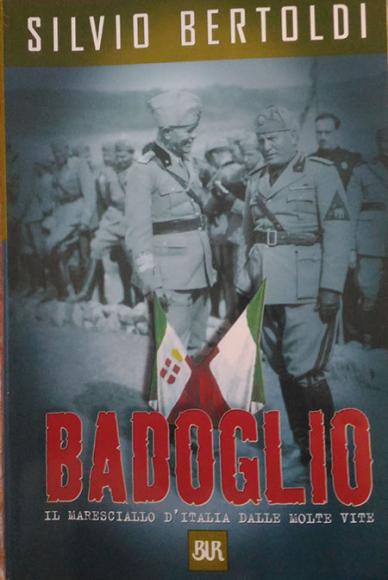Silvio Bertoldo
Ed. BUR
pp. 274
Badoglio: The Marshal of Italy of many lives. So says the title and subtitle.
Pietro Badoglio is appointed Marshal of Italy the 25 June 1926.
It should be remembered that the rank of "Marshal of Italy" was established in 1924 by Mussolini to honor Cadorna and Diaz, who had commanded during the 1st World War.
Then the same Mussolini used the grade as a reward for some general officers who had particularly distinguished (always during the Great War!), Among these, in '26, Pietro Badoglio.
But what made Badoglio so sensational?
Pietro Badoglio was born in Grazzano Monferrato on September 1 1871. He entered the Royal Academy of Turin in the 1888 and two years later he began his brilliant military career.
The author, Silvio Bertoldi, states that Badoglio was part of Freemasonry and that this allowed him to some extent to always have some safe card to play.
When Italy entered the war (23 May 1915 declares war on Austria-Hungary) Badoglio is a lieutenant colonel, assigned to the General Staff of the 2 ^ Army, at the command of the 4 ^ Division, then grappling with the problem of conquest of Mount Sabotino, fortified position of the Austrians, in defense of Gorizia, a city that since the 1500 was part of the Austrian territory.
Meanwhile Badoglio advances in rank. In May of 1916 he was promoted to colonel and was appointed Chief of Staff of the IV Army Corps.
Il Sabotino was the thorn in the side of General Montuori, commander of the IV division. For a year, they tried to attack the station without succeeding. The soldiers were discouraged.
According to the testimony of General Montuori it was Badoglio himself who explained how to do it:
"Using the parallel system, as I was taught at the Artillery and Genius Application School. The Sabotino is a fortress and it must be attacked in the classic way of an operation against a reinforced front".
Not everyone agrees that Badoglio was the creator of the plan, the fact is that it was he who reaped the benefits. However, it seems certain that as commander of the first 74 infantry regiment - which operated precisely in preparation for the attack on the Sabotin - and then as an outsider to check the continuation of the work carried out by the 139 regiment of the brigade Bari and by the two regiments of the brigade Wolves of Tuscany, did a great job.
The 6 August 1916 Sabotino is taken.
The commander of the 45 division is General Venturi, Badoglio is the commander of the mixed Brigade that carries out the attack. After the attack Badoglio returned to the VI army corps, where he was chief of staff. The division commander wanted to punish him for not continuing the action in depth. Instead, General Capello proposed him for a promotion to the Duke of Aosta, commander of the Third Army.
Badoglio, at 45 years, is named major general.
In the 1917 he took part in the battle of Bainsizza taking the place first of general Garioni (II army corps) and then of general Vanzo (XXVII corps), torpedoed by Capello.
He does what he can and eventually finds himself once again promoted to war lie to Lieutenant General. Badoglio is now in command of the XXVII army corps.
Perhaps Badoglio had made his career too fast, perhaps he overestimated his skills as a strategist, the fact is that, just when he should not fail, his fall comes which is called Caporetto!
I say he shouldn't have failed because he had all the information he needed to win. In fact, the 20 October 1917 a deserter officer showed up on the Isonzo lines. He carried with him the plans of attack of the Austro-Hungarians. Everything was known, day, time, adversary device and attack mode. Perhaps that was the problem, too much was known and this led the generals to the front to make their plans and to forget too easily that there is a hierarchy.
Badoglio was calm, he had arranged his troops as he thought best (not as he had been ordered to do!) And had given his orders, he had reserved the right to give the shooting order to the artillery. Perhaps he had thought of luring the enemy into a trap, an enemy that according to known information had to pass right into his sector. Among the enemies there were also the Germans and among them a very young officer, Rommel.
The fact is that the enemy broke his forehead exactly where everyone knew he would pass.
Badoglio, instead of being on the front, on the Ostri-Kras, from where he could have given the artillery the order to shoot, found himself back on Cosi.
He was cut off from his army corps and was unable to give any orders or to know what was happening on the front.
We all know the result. The front was broken and the Italian troops withdrew (not really neatly) until they reached the Piave.
Bertoldi's book carefully examines the battle of Caporetto attributing to Badoglio its share of responsibility and then continues in the story of his successful life. Badoglio that from Caporetto came out as a winner despite the defeat, he had to enjoy very high end support, the file containing the accusations against him disappeared and so he was the only one (and principal responsible of the defeat) that he found himself promoted.
Caporetto will not be Badoglio's last defeat. First there was Greece, then World War II sees him among the main culprits of the unpreparedness of the army when it entered the war and therefore of the complete unpreparedness of the armed forces left without orders after the armistice of 8 September 1943. Since the fall he was the prime minister of Mussolini, on behalf of the King.
But even then Badoglio was able to recover and went on to hold the office of prime minister until the end of the war, this time perhaps given by the Allies who considered him a trusted man.
In the 1944, at the age of 73 years, his successful career ended.
He had to live a long time, he died at the age of 85 years, but his fortune had abandoned him and what he had given him in life (fame, money, power and family), he was taken away in recent years.
Alessandro Rugolo












